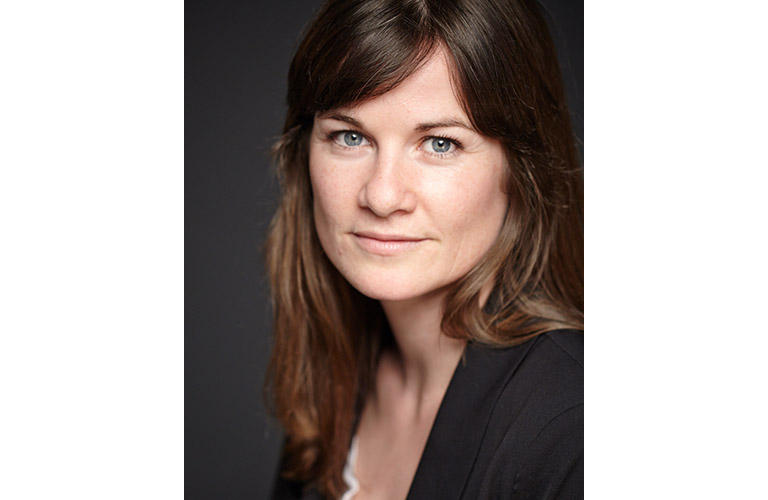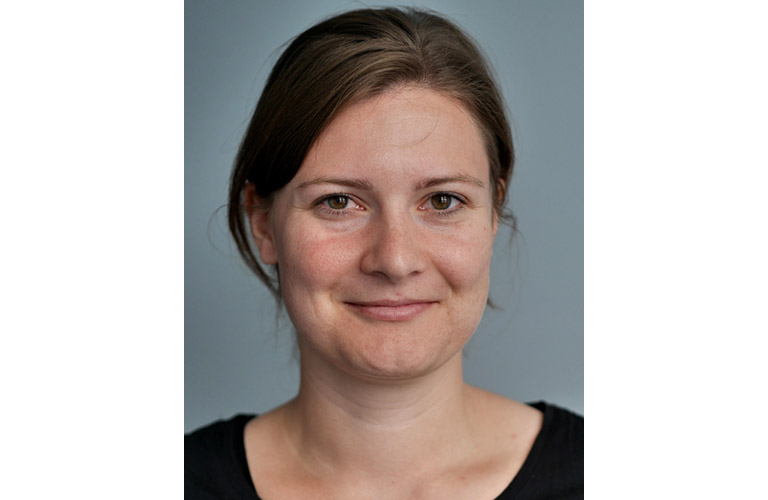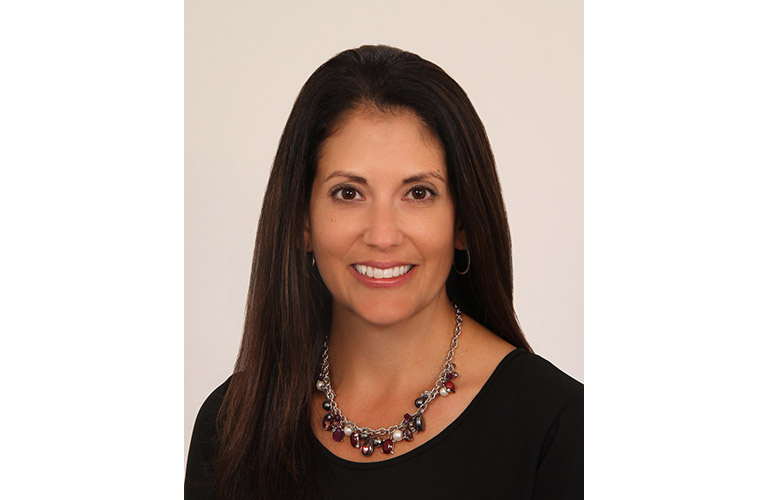New Wireless, Binaural Processing Reduces Problems Associated with Wind Noise in Hearing Aids
By Katja Freels, Dipl.Ing., Claudia Pischel, MSc, Cecil Wilson, MSc and Tish Ramirez, AuD
AudiologyOnline, October 12, 2015
Learning Outcomes
After reading this article/text course, the participant will be able to: describe how eWindScreen binaural works; explain the criteria that define an efficient wind noise reduction system; and, describe study results conducted with eWindScreen binaural.
Introduction
With today’s hearing aid technology, we have become accustomed to providing significant aided benefit for our patients in a variety of listening conditions. Speech recognition in both quiet and in background noise is improved. Most patients have improved sound quality and spatial localization. Research also has shown that listening effort and fatigue is reduced when hearing aids are used. A lot of good things are happening. But what about listening outdoors when the wind is blowing? Paradoxically, this isn’t a complaint you typically hear from patients before they start wearing hearing aids, but do you hear about it after they start using amplification? Much too often.
When fitting patients with new sophisticated instruments, we don’t usually consider that we could be giving them a problem that they didn’t have before, but regarding wind noise, that often is exactly what we are doing. MarkeTrak VIII data reveals that only 58% of hearing aid users are satisfied with the performance of their hearing aids in windy situations, the lowest rating for the eleven different listening conditions surveyed (Kochkin, 2010). The satisfaction for wind noise was poorer than factors such as listening in noisy situations, sounds too loud, and acoustic feedback issues.
Not only is wind noise annoying, it can significantly impact speech understanding, to the point that some patients find that they do better without their hearing aids for this listening condition. Or in some cases, they use only one of their two hearing aids. Clearly, this is a problem that needs to be solved.
Wind Noise – Why it Happens
Wind noise is created when the air turbulence moves across the hearing aid microphone ports, causing a vibration of the microphone membrane. This isn’t something unique to hearing aid microphones, but occurs for microphones in general—you often see the foam ball microphone cover being used in outdoor newscasts. Compared to the typical pressure from everyday speech and background noise, this is a tremendous force. It causes vibrations at a wide range frequencies, which are then converted into electrical signals and amplified.
The negative effects of wind for the hearing aid user will depend on the location of the microphone ports, the angle of the wind, the velocity of the wind, and the programming of the hearing aid. In general, the output will be the greatest in the lower frequencies, and can be 80 dB SPL or greater for some angles and wind flow levels. For example, Figure 1 shows the effects of wind measured on the ear of the KEMAR with a mini-BTE product programmed for a typical downward sloping hearing loss with a relatively tight-fitting coupling dome. Observe that the output caused by the wind alone (no audio input) peaks in the lower frequencies with an output of 70-80 dB SPL, and continues to be 60-70 dB SPL from 1000-3000 Hz, important frequencies for speech recognition. These output values shown in Figure 1 clearly illustrate why wind noise can be irritating, and why it can impact speech understanding.
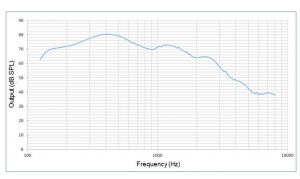
Figure 1. Illustration of the ear-canal SPL generated by wind, measured on the ear of the KEMAR using a mini-BTE product programmed for a typical downward sloping hearing loss with a relatively tight-fitting coupling dome. Observe that the spectrum is similar to that of loud speech, which helps explain why this signal masks speech communication so effectively.
Development of an eWindscreen
Historically, manufacturers have used different housings and a variety of guards, shields, and screens over the microphone ports in an attempt to buffer some of the effects of wind. These have been only moderately successful, as the covering must be cosmetically acceptable, and cannot be so great that it will affect the performance of the hearing aid. Fortunately today, many of the problems associated with wind can be minimized electronically through the use of advanced signal classification and digital signal processing. We’ll refer to this process as an eWindscreen.
Wind noise is created when the air turbulence moves across the hearing instrument microphone ports. This usually is caused by the velocity of the wind, but also is present if the hearing aid user simply is moving fairly rapidly, such as walking briskly. It is then even greater for other activities such as riding a bicycle or jogging. In a typical listening situation, when speech arrives at the two omnidirectional microphones of a single hearing aid, the signals are highly correlated. However, when wind is present, because of the turbulences set up by the wind within the microphone ports, the two signals are different and not correlated. This is illustrated in Figure 2. This negative effect from the wind is present for all styles of hearing aids, but is most noticeable for the behind-the-ear (BTE) and full-custom styles. For in-the-canal (ITC) and completely-in-canal (CIC) products, the resulting location of the microphone ports within the concha will reduce the wind noise disturbance for some wind azimuths.
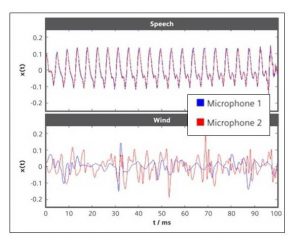
Figure 2. Illustration of the correlation of the input signals for the two omnidirectional microphones of a BTE instrument. On the top, the speech signals arriving at the two microphones are correlated. On the bottom, wind generates turbulence at the microphone ports and results in signals that are not correlated. The pattern shown on the bottom is unique to wind, and is reliably identified by the hearing aid’s classification system.
Most all of today’s sophisticated hearing aids have a signal classification system. This system analyzes the incoming signal to determine the listening situation the patient is experiencing. Listening environments can be classified as quiet, speech-in-quiet, speech-in-noise, noise, music, traveling car noise, etc. Depending on the classification, specific features may be automatically activated—for example, directional processing and noise reduction for the speech-in-noise classification. As we mentioned, the turbulences set up by the wind within the microphone ports creates a very unique pattern. The classification system of the hearing aid can use this information to determine when wind is creating a dominant amplified signal.
Once the signal classification system has determined that wind is present, the Siemens eWindscreen utilizes Wiener Filter technology to reduce the amplitude. Importantly, this analysis occurs independently in each channel, and therefore, the degree of gain reduction also is channel-dependent. By design, Wiener Filter technology is fast acting, which works for the patient’s advantage for situations when wind gusts are intermittent, of various velocities, and come from varying directions, due to the patient’s head turns.
In addition to Wiener Filter triggered gain reduction, the eWindscreen algorithm will also adjust to an omnidirectional mode, but only in the channels where wind is detected. This is necessary, because while directional processing is effective for reducing noise when the signals are correlated, when the signals for the two microphones are uncorrelated, as they are with wind turbulence, directional processing will increase the noise level. This is because directional patterns that are generated by digital signal processing have inherent high-pass characteristics (direct consequence of the delay-and-add approach). Therefore, in order to obtain a consistent satisfactory frequency response in an automatic program, where microphone modes fade from omnidirectional to directional, and can be in any interim overlay status at any time; the frequency response of the directional microphone pattern needs to be matched in the low frequencies to the omnidirectional microphone response. This means that the low frequencies obtain additional gain in the directional mode – a problem for wind noise, a condition where low frequencies are generated. Directional processing will still be maintained in the higher frequencies which are more important for optimal speech intelligibility.
While the monaural eWindscreen approach described here has proven to be successful over the years, wind reduction can be even more effective using wireless audio binaural processing. This is the technology that allows for binaural beamforming, but there also are applications for reducing wind noise.
eWindscreen Binaural
In the previous section, we describe the function of an eWindscreen in a monaural design. Recent advancements have led to wireless audio signal streaming between hearing aids, making binaural audio signal processing possible (for review see Kamkar-Parsi, Fischer, & Aubreville, 2014). This technology has been shown to provide advanced directional benefit (Aubreville & Petrausch, 2015) and is beneficial for improving speech understanding in background noise (Powers & Froehlich, 2014). It also can be used to enhance the eWindscreen effectiveness—we’ll refer to this as eWindscreen binaural. Depending on how much wind noise is detected in each channel, eWindScreen binaural first utilizes the monaural Wiener Filter technology to reduce the noise in each channel instantaneously and separately in both hearing aids.
More likely than not, wind noise is asymmetric at the two ears. Even when wind originates directly from the front of the hearing aid user, it is probably not exactly the same in both ears, and we naturally tend to turn our heads slightly to one side or the other. In these common asymmetric wind conditions, eWindScreen binaural activates e2e wireless 3.0, the wireless audio signal streaming technology, and streams part of the signal from the side with less intense wind noise to the other side where the wind noise is greater (see Figure 3). Additionally, for reasons described earlier, both hearing aids will automatically switch to omnidirectional processing for the channels where wind noise is prominent.
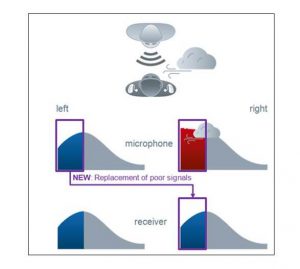
Figure 3. The eWindScreen binaural works by streaming the low frequency signal from the side with less wind to the side with stronger wind. The effect is a rapid reduction of wind noise without compromising speech intelligibility or spatial perception. In this example, the wind noise is the greatest at the right hearing aid, and therefore, the low-frequency information from the left hearing aid is transferred to the right.
The effects of the eWindscreen binaural are shown in Figure 4. These measures were obtained as described for Figure 1. Observe a substantial 20 dB or so reduction of the wind noise through 1500 Hz. Note that when the eWindscreen is applied, the noise level is now below what we would expect for average speech, reducing the masking effect of the wind.
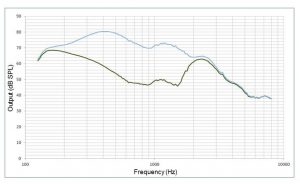
Figure 4. Ear-canal SPL generated by wind, measured on the ear of the KEMAR using a mini-BTE product programmed for a typical downward sloping hearing loss with a relatively tight-fitting coupling dome. The top curve is with eWindscreen binaural “off,” the lower curve is with the binaural algorithm “on.” Observe that the reduction is as much as 25 dB at some frequencies.
Importantly, because only part of the signal is streamed from one side to the other, spatial perception is maintained. eWindScreen binaural is activated automatically when necessary, and no wearer interaction is required. This automatic activation will happen in all programs. That is, in the commonly used automatic “Universal” program, there would never be a need for the patient to manually switch to a special “wind program.”
Research Findings with eWindscreen Binaural
To study the effectiveness of the eWindscreen binaural, we examined its impact on speech understanding and hearing aid users’ judgments regarding audibility, sound quality and annoyance. The participants were 17 adults with moderate-to-severe sensory/neural hearing loss. They were fitted bilaterally with binax Carat 7bx instruments, with double domes. The hearing aids were fitted according to the Siemens binax fit algorithm, and all features were activated. Comparative testing was conducted with the eWindscreen binaural either activated or not activated.
For the test conditions, the participants were seated in the center of eight surrounding speakers, placed at 45 degree increments (see figure 5).

Figure 5. Setup for listening tests with eWindScreen binaural. Target speech was presented from 45 degree, with the wind presented from 270 degree. To enhance the listening situation, visual scenes depicting the environment were shown on a monitor in front of the participant.
The target speech signal was presented from 45 degree, and the wind, generated by a small quiet fan, originated from 270 degrees. Two different soundscapes were used: beach with ocean noise, and traffic noise on a busy street. To enhance the realism of the listening situation, a visual representation of the scene was shown on a monitor located in front of the participant.
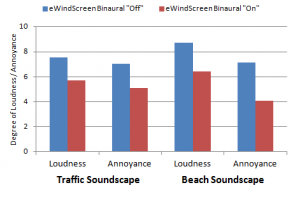
Figure 6. Mean subjective ratings for loudness and annoyance with the eWindscreen on versus off for two different listening conditions: traffic and beach. Rating 10 =”Very Loud” or “Very Annoying.” Note that for both soundscapes, and for both annoyance and loudness, significant improvement was noted when the eWindscreen was activated.
Figure 6 shows the mean participants’ ratings for both loudness and annoyance of the wind noise for the traffic and beach soundscapes (a rating of “10” = very audible or very annoying). Observe that for the traffic listening situation, the loudness of the wind was reduced from 7.5 to 5.7 with the eWindscreen binaural activated. The loudness of the wind was rated higher for the beach condition (8.8), with an improvement to 6.3 when the eWindscreen was activated. A similar pattern showing benefit for the eWindscreen binaural was observed for annoyance, with improved ratings of 7.0 to 5.1 for traffic, and 7.1 to 4.0 for the beach listening condition.
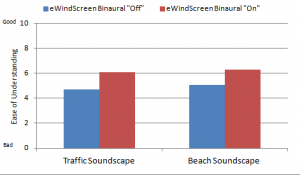
Figure 7. Mean subjective ratings for ease of speech understanding with the eWindscreen “On” versus “Off” for two different listening conditions: Traffic and Beach. Rating 10 = “Very easy to understand.” Observe that for both soundscapes, the speech was found to be easier to understand when the eWindscreen was activated.
Subjective ratings of speech understanding also were assessed, shown in Figure 7. For these ratings the participants listened to the target speech with the background noise and wind present. Observe that when eWindscreen binaural was activated, the mean rating for “easy to understand” improved from 4.8 to 6.1 for the traffic sound scape, and from 5.0 to 6.2 for the beach listening situation. These findings are in agreement with the measured speech recognition, which was conducted using the Freiburg monosyllabic test (DIN 45621). This testing revealed up to 30% improvement in word recognition with the eWindscreen binaural activated.
Finally, the ability to localize sounds was not degraded for both listening situations, as shown in figure 8. Spatial hearing was rated essentially identical for both soundscapes with the eWindscreen “On” compared to “Off.” This supports the notion that the reduction of annoyance and improvement in speech understanding can be accomplished with no negative effects.
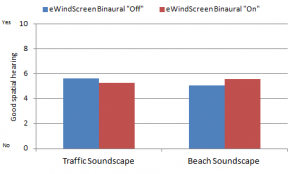
Figure 8. Mean subjective ratings for spatial hearing with the eWindscreen “On” versus “Off” for two different listening conditions: Traffic and Beach. Rating 10 = “Good spatial hearing.” Observe that for both soundscapes, the ability to localize sounds was not degraded.
Perhaps the most significant finding was the participants’ final preference judgment for the two different settings. For the traffic scenario, 17 of 17 participants preferred listening with the eWindscreen “on”; the preference was 16 of 17 for the beach sound scape.
Summary
Surveys suggest that wind noise continues to be a significant problem for many hearing aid users. Satisfaction ratings for listening in wind are poorer than most all other conditions surveyed, even worse than listening in background noise. And, these satisfaction ratings have not improved substantially from surveys of ten years ago. However, through the use of wireless audio streaming between hearing aids, we have developed a binaural eWindscreen that has been shown to provide substantial benefit for this listening situation. Research revealed that this algorithm substantially reduces the loudness of the wind noise, reduces annoyance, and makes speech in the presence of wind easier to understand. The participants in this study overwhelmingly favored the use of this application. Importantly, this algorithm functions automatically and seamlessly in all programs of binax technology.
References
Aubreville, M., & Petrausch, S. (2015) Measuring directivity of modern hearing aids. Canadian Audiologist, 2(3). Retrieved from http://www.canadianaudiologist.ca/measuring-directionality-of-modern-hearing-aids/
Kamkar-Parsi, H., Fischer, E., & Aubreville, M. (2014) New binaural strategies for enhanced hearing. Hearing Review, 21(10),42-45.
Kochkin, S. (2010). MarkeTrak VIII: Customer satisfaction with hearing aids is slowly increasing. The Hearing Journal, 63(1), 11-19.
Powers, T., & Froehlich, M. (2014). Clinical results with a new wireless binaural directional hearing system. Hearing Review, 21(11),32-34.
